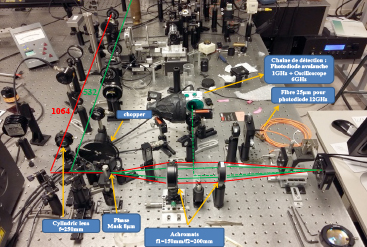List of members |
Facilities |
Internships and jobs |
PhD |
Publications |
News |
Assembly Transient Networks / 4 Wave Mixing (100 MHz – 2 GHz)
(1 Quantel Picosecond laser 20Hz + 1 Verdi Coherent continuous laser 2W).
This experimental technique, known as transient grating, or “4-wave mixing”, is particularly well suited to measure the dispersion properties of thin films, but also of ordered or disordered nanostructures such as phononic crystals and acoustic metamaterials, at frequencies up to a few GHz. It consists in exciting stationary surface elastic waves on the surface of a sample, through photoelastic processes, by illuminating the sample with interference bangs produced by two picosecond optical pulses in the near infrared. The wave vector of this elastic wave can be easily selected by adjusting the angle between the two incident beams. Heterodyne detection of elastic waves is done by mixing on a fast photodiode, the signal reflected by the sample (thus modulated at the frequency of the elastic waves) with a reference signal.

Caption: Left: “transient array” assembly. In the middle : typical frequency spectrum of the generated signal shown in the insert, for L = 5.85 µm. Right: measurement of the dispersion of surface acoustic waves in flexible piezogenerators made of Gallium Nitride nanowires (GaN/NWs) integrated in an HSQ dielectric matrix (top right).

Pump-probe assembly for the generation and detection of surface waves (1 GHz – 5 GHz)
(1 Chameleon 80MHz Coherent 4W femtosecond laser).
We have recently completed the previous experimental set-ups with a pump-probe assembly designed to study the co-location of photons and phonons with frequencies up to 5 GHz, on surfaces randomly covered with acoustic resonators.

